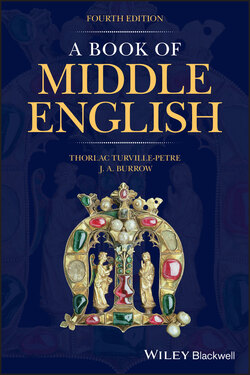Читать книгу A Book of Middle English - J. A. Burrow - Страница 12
1.1.1 From Old to Middle English
ОглавлениеThe Old English described in our companion volume, Mitchell and Robinson’s Guide to Old English, is based on the language of the West‐Saxon kingdom as it was written in the days of King Alfred of Wessex (d. 899). It was the English of this part of the country which, in the last century before the Norman Conquest in 1066, came to be accepted as the standard written form of English. People went on talking in their own various dialects; but most of the English writings set down at this time (including most Old English poetry and prose known to us) conform to this Late West‐Saxon standard language. As is usually the case with such standards, this written English owed its predominance to a political fact: the predominance of Wessex itself under King Alfred and his successors over the other old kingdoms of Anglo‐Saxon England. But after 1066, Wessex became no more than one, rather remote, part of a French‐speaking king’s realm; and the language of Wessex accordingly lost its special status too, ending up eventually as just another form of written Middle English: ‘South‐Western’. This development goes a long way to explain why most writings of the twelfth century present such a different appearance from those of the tenth or eleventh. The language as spoken had, of course, changed in the interval, but the nature of our written evidence for it changed more drastically. Twelfth‐century scribes, unlike their Anglo‐Saxon predecessors, customarily employed whichever form of English they or their authors happened to use. Hence they represent in their writings changes which had already occurred in the spoken language of late Old English, but which had left no more than occasional traces in the writings of that period. For it is the nature of standard forms of language to be fixed and therefore conservative in the face of linguistic change. Three features particularly distinguish Middle from Old English:
1 A much simpler system of inflexions, especially in nouns and adjectives. A major cause of this simplification was the tendency to blur the distinction between vowel‐sounds in the unstressed syllables of words, reducing most of them to /ǝ/, the sound heard in the unstressed, second syllable of the modern word ‘China’. Since inflexional endings were regularly unstressed, this tendency obliterated many distinctions between them, e.g. between Old English stānes (genitive singular of the masculine noun stān, ‘stone’) and stānas (nominative and accusative plural). An associated change was the eventual loss in all Middle English dialects of ‘grammatical gender’ in nouns and adjectives, since the division of these into masculine, feminine and neuter in Old English had depended upon inflexional distinctions most of which failed to survive. (On inflexions generally, see chapter 4 below.)
2 Increased reliance upon word‐order and prepositions to mark the relationships of words in a sentence. This change also goes along with the simplification of inflexions. In many singular nouns, for instance, Old English had distinguished the nominative (subject) form from the accusative (object) form. Where that distinction was lost, as in Middle English generally, it was only word‐order that could distinguish the subject of a verb from its object. (On Middle English syntax, see chapter 5 below.)
3 An increasingly more ‘mixed’ vocabulary. English is in its origin a Germanic language. The vocabulary of Old English had relatively few words from other sources (though there were significant borrowings from the Latin of the Church). By contrast, Middle English draws heavily on French and Latin, and also on the languages of the Scandinavian settlers who had populated large areas of England (but not Wessex) in the later Anglo‐Saxon period. (On Middle English vocabulary, see chapter 3 below.)
